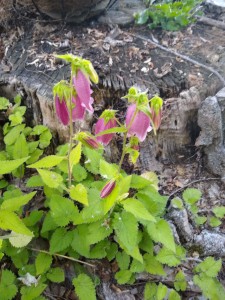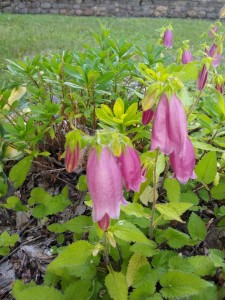 About five years ago I bought an alluring plant from a roadside stand in the Finger Lakes region of Central New York State. The “stand” was actually a large cart, laden with perennials that were clearly surplus specimens from someone’s well-stocked garden. The “someone” was nowhere to be seen. Among the offerings were gaillardia daisies, Shastas, catmint, and my choice, which was simply labeled “bellflower”. The single nodding “bell” that adorned my plant was about two inches long and dusty pink, with a narrow, lighter pink rim on the edge. The price was two dollars, which I deposited in the honor box at the end of the cart, before moving on. When I arrived back at our summer cottage, I planted my bellflower in a little bed that surrounds a large cottonwood stump.
About five years ago I bought an alluring plant from a roadside stand in the Finger Lakes region of Central New York State. The “stand” was actually a large cart, laden with perennials that were clearly surplus specimens from someone’s well-stocked garden. The “someone” was nowhere to be seen. Among the offerings were gaillardia daisies, Shastas, catmint, and my choice, which was simply labeled “bellflower”. The single nodding “bell” that adorned my plant was about two inches long and dusty pink, with a narrow, lighter pink rim on the edge. The price was two dollars, which I deposited in the honor box at the end of the cart, before moving on. When I arrived back at our summer cottage, I planted my bellflower in a little bed that surrounds a large cottonwood stump.
For all but about three weeks a year, my summer cottage garden is neglected. Any plant that survives—and many do—must make do on its own. The soil ranges from heavy clay at the top of the embankment that bounds our driveway, to shale beach by our dock. The tree stump bed is somewhere in between those two extremes. When I planted the bellflower, it joined several hostas, a couple of Asiatic lilies, some stalwart columbines, several healthy bearded iris, a few ajuga or bugleweed plants, and a “mourning widow” hardy geranium. The bellflower went in the sunnier half of the bed.
For some reason, I didn’t do any research on the new acquisition after I planted it. By the time I returned to our cottage the following spring, it had morphed into three plants. By summer those plants had sprouted a bevy of long, ridged buds and additional pink bells. Clearly the bellflowers were thriving without help in the deer-populated, USDA Zone 5 climate. That alone was worthy of further investigation.
Now I know the proper Latin name of those bellflowers, Campanula punctata, or even more formally, Campanula punctata f. rubriflora. This is loosely translated as “spotted bellflower with pink blossoms”. The plant’s admirers just call it “spotted bellflower”, or sometimes, “long-flowered bellflower”. The species is part of the very large Campanulaceae or harebell family, which includes about 2400 species, growing on every continent except Antarctica. Spotted bellflowers hail from Japan and Siberia, and most likely arrived here in the eighteenth or possibly nineteenth century. The plants grow one to two feet tall, rising from mats of toothed foliage. Ridged, capsule-shaped buds open into pendant, lantern-like flowers that may be up to three inches long. Each blossom is also broadly toothed at the bottom. Because the flowers hang from the stems, it takes effort to look inside them. If you do, you will see the purple spots that gave rise to both Latin and common names. 
Because of their vigor, I suspect that spotted bellflowers have long been popular “pass along” plants—the kind that you acquire from avid gardening friends, or the occasional roadside stand. I suspect that my plant is probably ‘Cherry Bells’, which seems to be the most readily available in horticultural commerce. Breeders have not latched on to Campanula punctata as they have with some other species, so you will not find scores of spotted bellflower varieties on the market. The Chicago Botanical Garden did a large-scale campanula evaluation in 2008 and listed nine different forms and varieties. Those with flowers in shades of dark pink and pink-purple predominate, including ‘Cherry Bells’, ‘Bowl of Cherries’ and ‘Vienna Festival’. ‘Alina’s Double’ is in the same color range, but with double bells, configured one inside the other in an arrangement that an older generation of English and American gardeners would call “hose in hose”. White Campanula punctata f. albiflora has also given rise to a cultivated variety called ‘Wedding Bells’. All the forms and varieties are characterized as “spreading”, so I know my bellflowers are typical of their species.
Since my spotted bellflowers are bent on moving towards world domination, I am going to separate a clump and take it back to my home garden. I will take great pleasure in them, since they hold up well in the garden and in cut flower arrangements. Deer allegedly do not like them. I will also make sure that I work to curb their rampant expansionistic tendencies.
You may not have a roadside stand nearby, but if you want ‘Cherry Bells’ to fill those blank spaces in the garden, you can get it from Digging Dog Nursery, 31101 Middle Ridge Road, Albion, CA 95410; (707) 937-1130; www.diggingdog.com. It appears to be harder to lay hands on other varieties, unless of course you live in horticultural paradises like the U.K., Australia and Canada. ‘Nana Alba’, a white-flowered variety, is available from Far Reaches Farm, 1818 Hastings Avenue, Port Townsend, WA 98369; (360) 385-5141; www.farreachesfarm.com.
